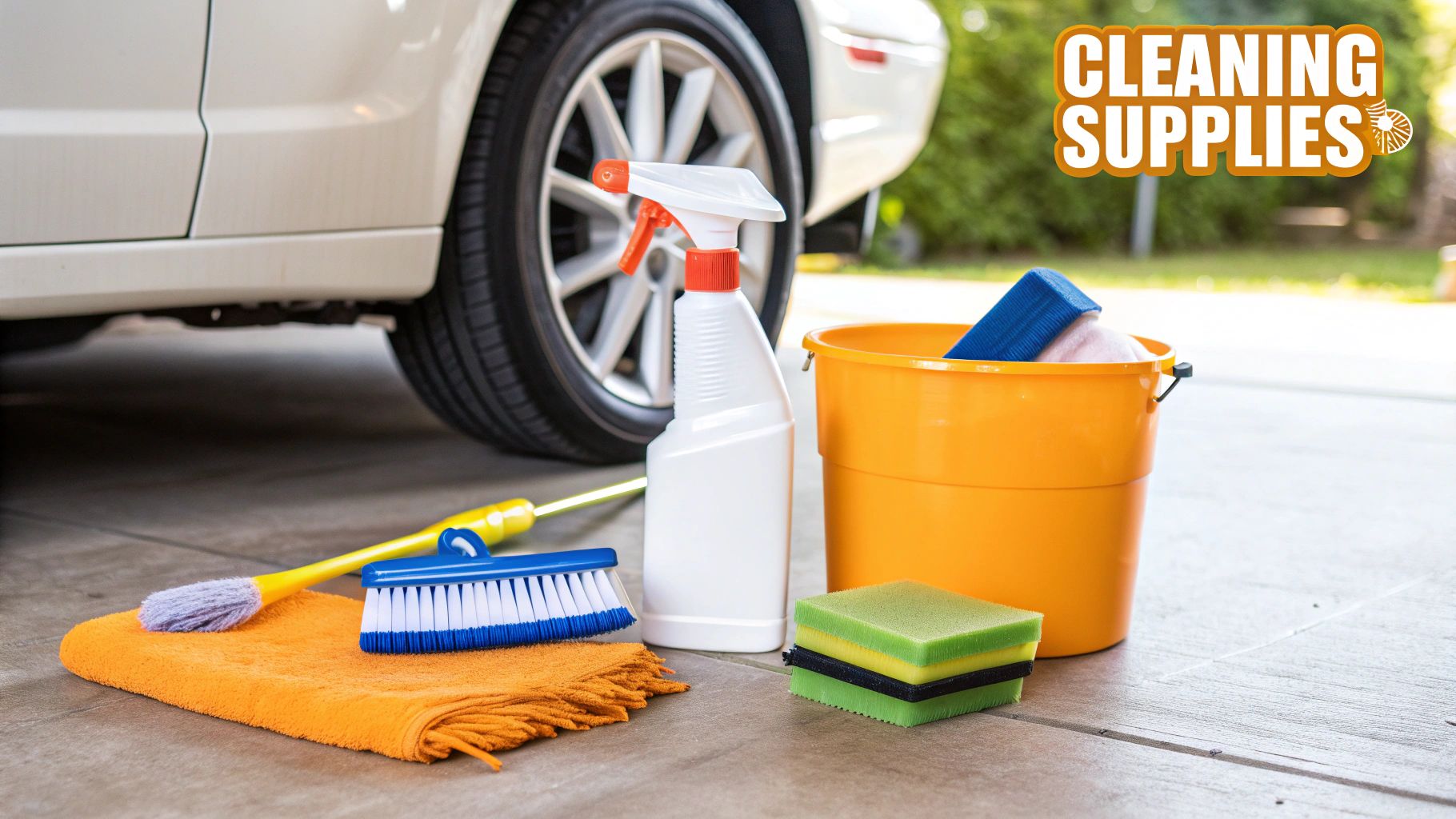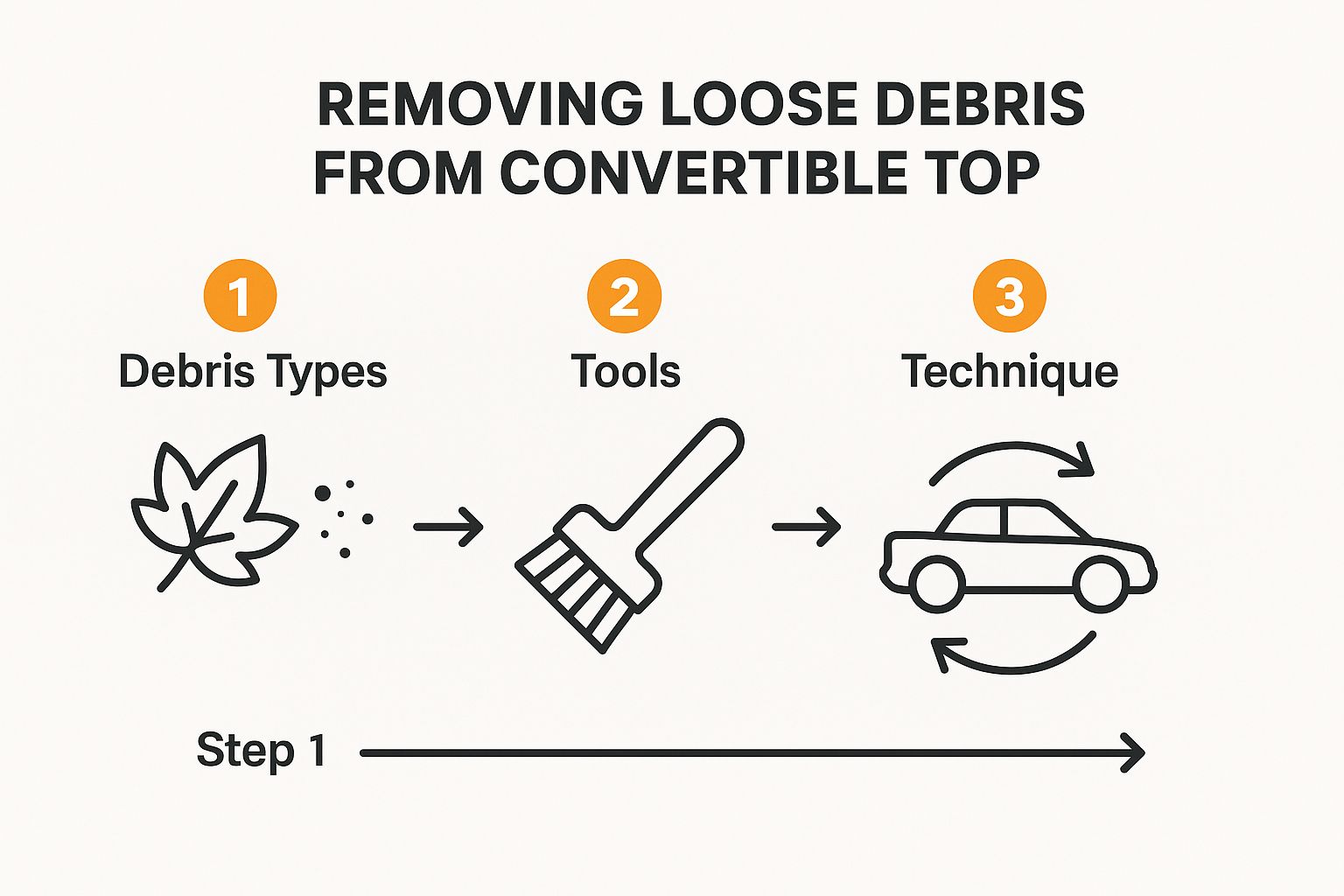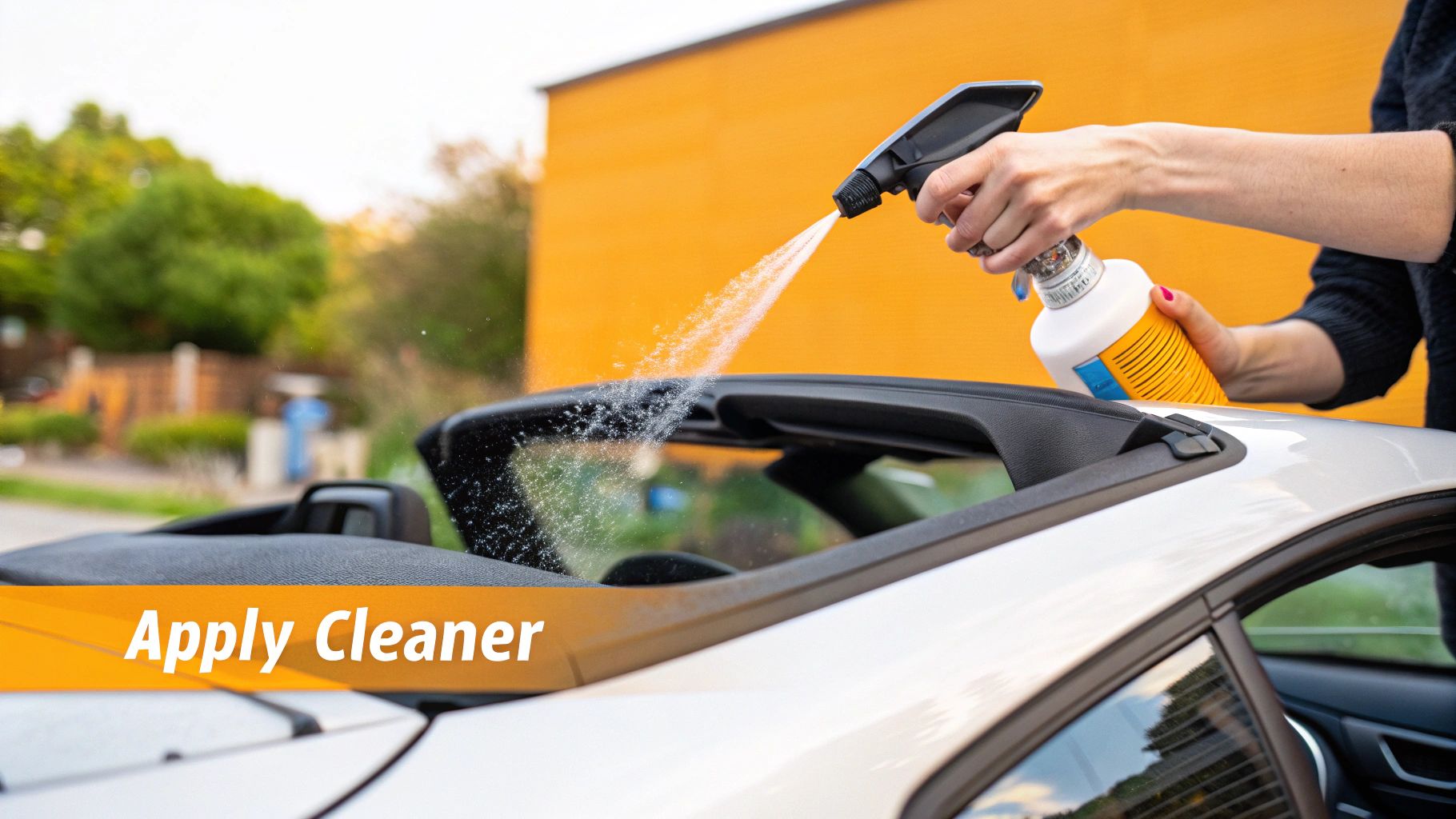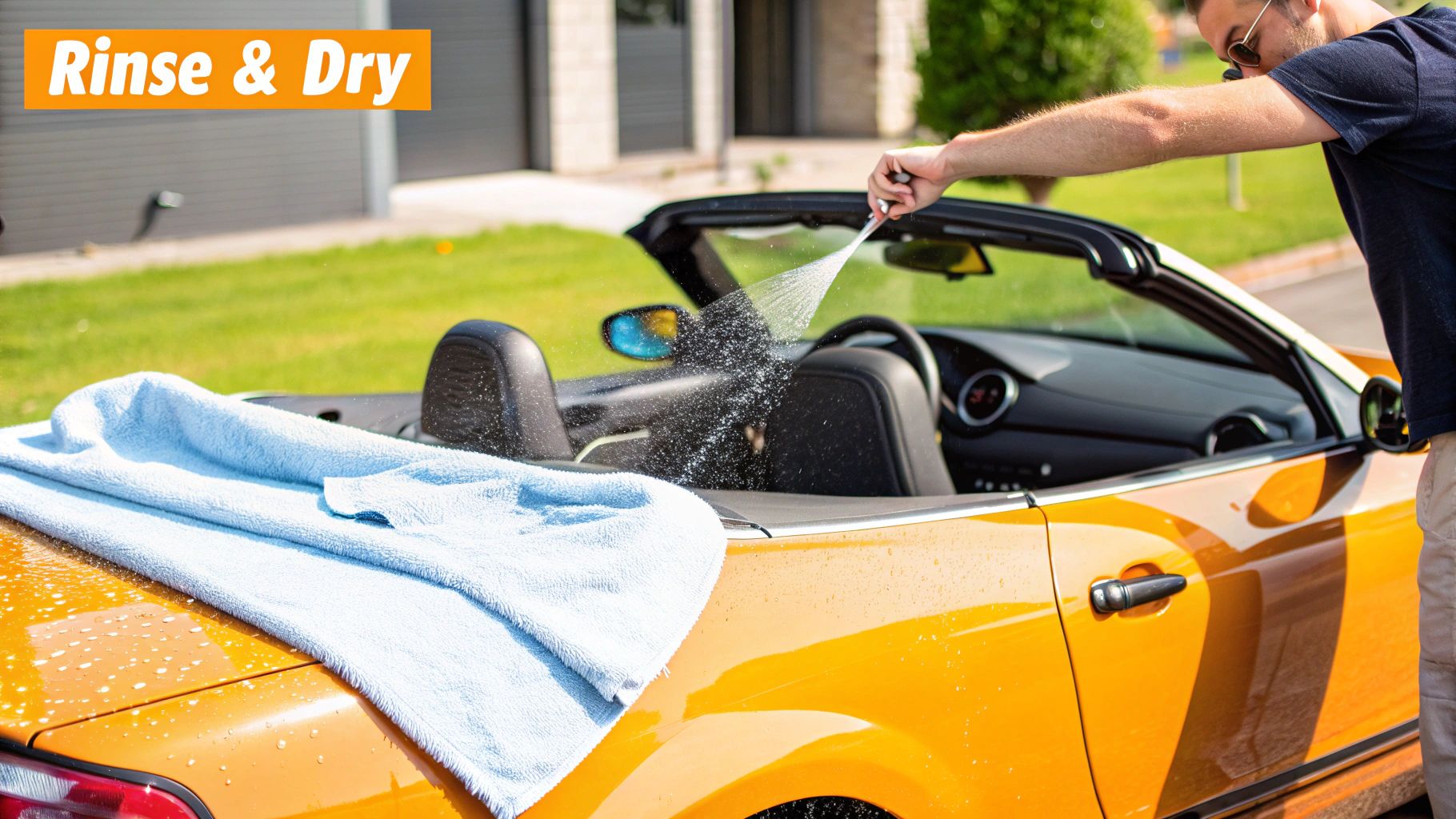Before you even think about getting your convertible top wet, the single most important step is figuring out exactly what you're working with. A clean soft top is a beautiful thing, but using the wrong products can cause irreversible fading or damage. So, let's get this first part right. The whole process boils down to smart preparation, a gentle but thorough wash, and a final layer of protection to keep it looking great.
What Kind of Top Are You Working With?
A pristine convertible top isn't just for looks—it’s a major part of your car that needs the right kind of care to prevent leaks, premature aging, and an expensive replacement bill down the line. The biggest fork in the road is whether your top is made of fabric or vinyl. They might look similar at a glance, but how you clean them couldn't be more different.

Fabric vs. Vinyl: The Critical Difference
So what’s the big deal? It all comes down to how the material is made. Fabric tops, which you’ll find on many European and high-end convertibles, are typically made from canvas, twill, or mohair blends. They have a woven, porous texture that will soak up water like a sponge if it isn’t properly sealed.
Vinyl, on the other hand, is essentially a sheet of plastic. It has a non-porous surface that naturally repels water.
Here’s a quick and easy test to tell them apart:
- Find a clean, inconspicuous spot on the top.
- Put a single drop of water on it.
- If the water soaks in pretty quickly, you’ve got a fabric top.
- If it just sits there beaded up on the surface, you’re looking at vinyl.
Once you know which material you have, you can confidently choose the right cleaner, brush, and protectant.
Key Takeaway: Grabbing a vinyl cleaner for a fabric top can strip its protective coating, leaving it vulnerable to leaks and stains. On the flip side, a fabric cleaner just won't cut through the grime on a vinyl surface. Getting this step right from the start is the secret to avoiding a costly mistake.
This simple check sets you up for a cleaning process that not only gets rid of dirt and grime but also preserves the top’s integrity, protecting it from UV rays and moisture for years to come.
To make things even clearer, here’s a quick rundown of what you’ll need for each type.
Fabric vs. Vinyl Top Cleaning at a Glance
This table breaks down the essentials for each material, ensuring you grab the right gear for the job.
| Material Type | Recommended Cleaner | Brush Type | Protectant Type |
|---|---|---|---|
| Fabric | pH-neutral, specially formulated fabric/canvas cleaner | Soft to medium-bristle brush (horsehair or synthetic) | Fabric guard with UV inhibitors and water repellency |
| Vinyl | pH-neutral vinyl cleaner or a quality all-purpose cleaner | Medium-stiff synthetic bristle brush | Vinyl protectant with UV blockers and a natural finish |
As you can see, while both require pH-neutral cleaners to avoid damage, the specific formulations and the tools you use are tailored to the material's properties. Getting this right is 90% of the battle.
Gathering Your Gear for a Perfect Finish
Using the wrong supplies is one of the quickest ways to turn a simple cleaning job into a costly repair. I've seen it happen too many times—someone grabs a household cleaner or a stiff-bristled brush, and before they know it, they've stripped the top's protective coating or frayed the fabric. When you're learning how to clean a convertible top, getting the right gear together first is non-negotiable.
Think of it this way: you wouldn't use a kitchen scouring pad on your car's paint, and your soft top deserves that same level of specialized care. For years, owners used harsh soaps that did more harm than good. It wasn't really until the 1980s that dedicated cleaners became common, with market research showing that by 1985, over 40% of convertible owners were finally using manufacturer-recommended products. That shift tells you everything you need to know about the importance of using the right stuff.
Your Go-To Cleaning Kit
Before a single drop of water hits your car, let's get your toolkit sorted. This little bit of prep work prevents any mid-wash scrambling and ensures you're cleaning safely and effectively.
- For Fabric Tops: Your best friend here is a medium-bristle brush. The bristles need to be firm enough to get into the weave and lift out stubborn grime, but not so stiff that they damage the delicate fibers.
- For Vinyl Tops: Put the brush away and grab a soft microfiber wash mitt. Vinyl is much more prone to scratching, and a gentle mitt is the safest way to work the cleaner in without causing any marring.
A real game-changer for applying cleaner evenly is a foam gun, like the SwiftJet. It lays down a thick, clinging foam that lets the cleaning solution do its job without running off or soaking too deep into the seams. It's all about control.
Rounding Out Your Supplies
With your main cleaner and applicator chosen, a few extra items will take your results from "good enough" to "like new." Having a complete set of car detailing supplies really does make all the difference.
You'll definitely want two separate buckets—one for soapy water and one filled with clean water for rinsing your brush or mitt. This two-bucket method is a pro detailer trick that prevents you from just rubbing the dirt you just removed right back onto the surface.
And finally, don't forget a healthy stack of high-quality, plush microfiber towels. These are essential for gently blotting the top dry, absorbing water without leaving behind annoying lint or causing streaks.
Mastering the Cleaning Process for Fabric and Vinyl
Alright, let's get our hands dirty. The single most important rule for cleaning a convertible top is to always work in the shade. If you try this in direct sunlight, the cleaner will evaporate way too fast, leaving you with a streaky, soapy mess that’s a real pain to get off. Trust me, finding a shady spot makes the whole process smoother and gives you the time you need to do the job right.
First things first, give the entire top a good rinse with a regular garden hose. You're not trying to blast it clean—in fact, you should absolutely avoid a high-pressure washer. That intense spray can tear up the delicate seams and fibers. The goal here is just to gently wash away all the loose dust, leaves, and surface-level grime before you start scrubbing.
This infographic gives you a quick visual breakdown of how to get that initial debris off before you even introduce a cleaner.

As you can see, a gentle sweep with the right brush is your first move. This dislodges things like dust and leaves before they get ground into the fabric by water and scrubbing.
Techniques for Fabric Tops
With the top still damp from the rinse, it’s time to bring in the suds. This is where a foam gun like the SwiftJet really shines. It lays down a thick, even blanket of foam that clings to the surface. This is perfect because it lets the cleaner soak into the fabric’s weave to do its job without completely saturating the material.
Once it's foamed up, grab a soft-to-medium bristle brush. For fabric tops, you'll want to use a pH-neutral shampoo and gently scrub in small, overlapping circles. This motion is really effective at lifting the dirt out of the weave without fraying the material. This isn't just about looks; getting that embedded grime out helps protect the top from premature wear and UV damage.
When you're done scrubbing, rinse the top thoroughly. And I mean thoroughly. Keep rinsing until the water running off is perfectly clear. That’s your signal that all the soap and dirt are gone.
Handling Vinyl Tops with Care
Vinyl is a different beast and requires a much gentler touch to prevent scratches. Ditch the brush for this one and use a soft microfiber wash mitt instead. You can apply a gentle, pH-neutral car shampoo or a dedicated vinyl cleaner right onto the mitt, then wash the top using straight, overlapping lines.
Pro Tip: Whatever you do, never use a circular motion when cleaning a vinyl top. This is a surefire way to create fine swirl marks, which are incredibly noticeable on darker vinyl. Stick to straight-line passes for a clean, flawless finish.
For most routine cleaning, this gentle approach is all you need. It’s interesting how these same principles—using the right cleaner and avoiding harsh scrubbing—apply to other big outdoor fabric surfaces, too. We cover a similar process in our guide on how to clean an RV awning.
After washing, give the vinyl top a final, thorough rinse. And while you can get great results at home, if you're chasing that perfect, just-off-the-lot look, consider professional exterior hand wash and wax services to really restore its shine.
Applying a Protectant for Long-Term Defense
Don't make the classic mistake of stopping after the wash. Cleaning your convertible top is only half the battle. If you skip the protection step, you're essentially leaving all your hard work exposed to the very elements you just cleaned off. This is the crucial final step that locks in that fresh look.

Just like with the cleaners, you have to match the protectant to your top’s material. Grabbing the wrong bottle can do more harm than good.
- For fabric tops, you’ll want a dedicated fabric guard. This stuff is brilliant—it creates a hydrophobic barrier that makes water bead up and roll right off instead of soaking in. More importantly, it provides essential UV protection to keep the sun from bleaching out the color.
- For vinyl tops, a quality vinyl conditioner is your best bet. These formulas are designed to feed the material, keeping it supple and preventing the cracking, drying, and fading that vinyl is so prone to.
The Correct Application Method
Applying these products is straightforward, but the details matter. Before you even think about spraying anything, make sure the top is 100% bone dry. I can't stress this enough. Sealing a damp top is a recipe for trapping moisture, which will almost certainly lead to mildew.
Hold the can or spray bottle about 8-12 inches from the top and apply a light, even coat. I find a steady, sweeping motion works best, slightly overlapping each pass to get uniform coverage. You're aiming for a fine mist, not a drenching.
Crucial Tip: Always keep a clean microfiber towel in your other hand. You will get some overspray on the glass and paint, and you need to wipe it up immediately. Dried-on protectant can be a real pain to remove later. This is just as vital as knowing the best way to protect car paint in the first place.
How Often to Reapply
So, how often do you need to do this? For most people, reapplying the protectant every 3-6 months is a good schedule.
But really, it all comes down to your car's lifestyle. If your convertible is a daily driver that sits outside in the sun and rain, you might need to re-up that protection every 2-3 months. On the other hand, if it’s a garage-kept weekend cruiser, you can probably get away with doing it twice a year.
Here are some common missteps I see people make all the time when trying to clean their convertible top. Knowing what not to do is just as important as the cleaning process itself. Let's make sure your good intentions don't lead to a costly repair.
Steer Clear of These Convertible Cleaning Pitfalls
The absolute biggest mistake you can make is grabbing a high-pressure washer. I get it, it seems like the fastest way to blast away stubborn grime. But that powerful stream is way too aggressive for convertible materials—it can shred seams, destroy window seals, and even tear right through the fabric. Your best friend here is a standard garden hose with a gentle spray nozzle.
What you clean with is just as critical. Many people reach for whatever they have under the sink, and that’s a recipe for disaster.
- Avoid Ammonia-Based Cleaners: Household glass cleaners are a huge no-go. The ammonia in them will discolor your top and can make vinyl brittle and prone to cracking.
- Don't Use Stiff Brushes: Using a harsh, abrasive brush is like taking sandpaper to your top. It will fray the fibers on a fabric roof and leave permanent scratches on a vinyl one.
One of the most damaging things you can do happens right at the end. Never, ever fold your top down when it's still damp. This is a surefire way to trap moisture, leading to mildew growth, musty smells, and permanent creases in the fabric. A little patience goes a long way here—always let it air dry completely before retracting it.
Common Questions About Convertible Top Care
Even after you've got the basic process down, questions pop up. It's totally normal. Knowing the answers to a few common head-scratchers is what separates a good cleaning job from a great one. Let's tackle some of the questions I hear all the time.

How Often Should I Clean My Convertible Top?
For regular maintenance, just rinsing the top down every couple of weeks goes a long way. But when it comes to a proper deep clean with soap and a brush, aim for at least twice a year.
I usually recommend doing this in the spring to wash away winter grime and again in the fall to prep it for the tougher weather ahead. Of course, if you park under a sappy tree or live in a dusty area, you might need to do it more often.
Can My Convertible Go Through an Automatic Car Wash?
In a word: no. I’d strongly advise you to avoid automatic car washes entirely. Those high-pressure jets are powerful enough to damage the delicate weather seals around your windows and roofline.
And those giant, spinning brushes? They can leave permanent scratches on vinyl tops and cause fabric tops to fray and look fuzzy over time. Your best bet is always a gentle hand wash.
What's the Best Way to Handle Stubborn Stains?
The key to dealing with things like bird droppings or tree sap is to act fast. Don't let them bake in the sun.
When spot cleaning, always act quickly. For fresh bird droppings, lift away any solids first, then treat the spot with your convertible top cleaner. If you're dealing with hardened tree sap, you might need a dedicated spot remover, but be sure to test it on an inconspicuous area first to ensure it's safe for your material.
For most fresh stains, the process is simple: carefully lift off any solid bits, apply your cleaner directly to the spot, and gently work it in with a soft brush before rinsing everything away.
Ready to make cleaning your top easier and more effective? The SwiftJet Foam Gun gives you that perfect, even layer of cleaner without oversaturating the fabric. It’s the secret to a professional-grade finish every single time. Get yours today and see the difference it makes!
